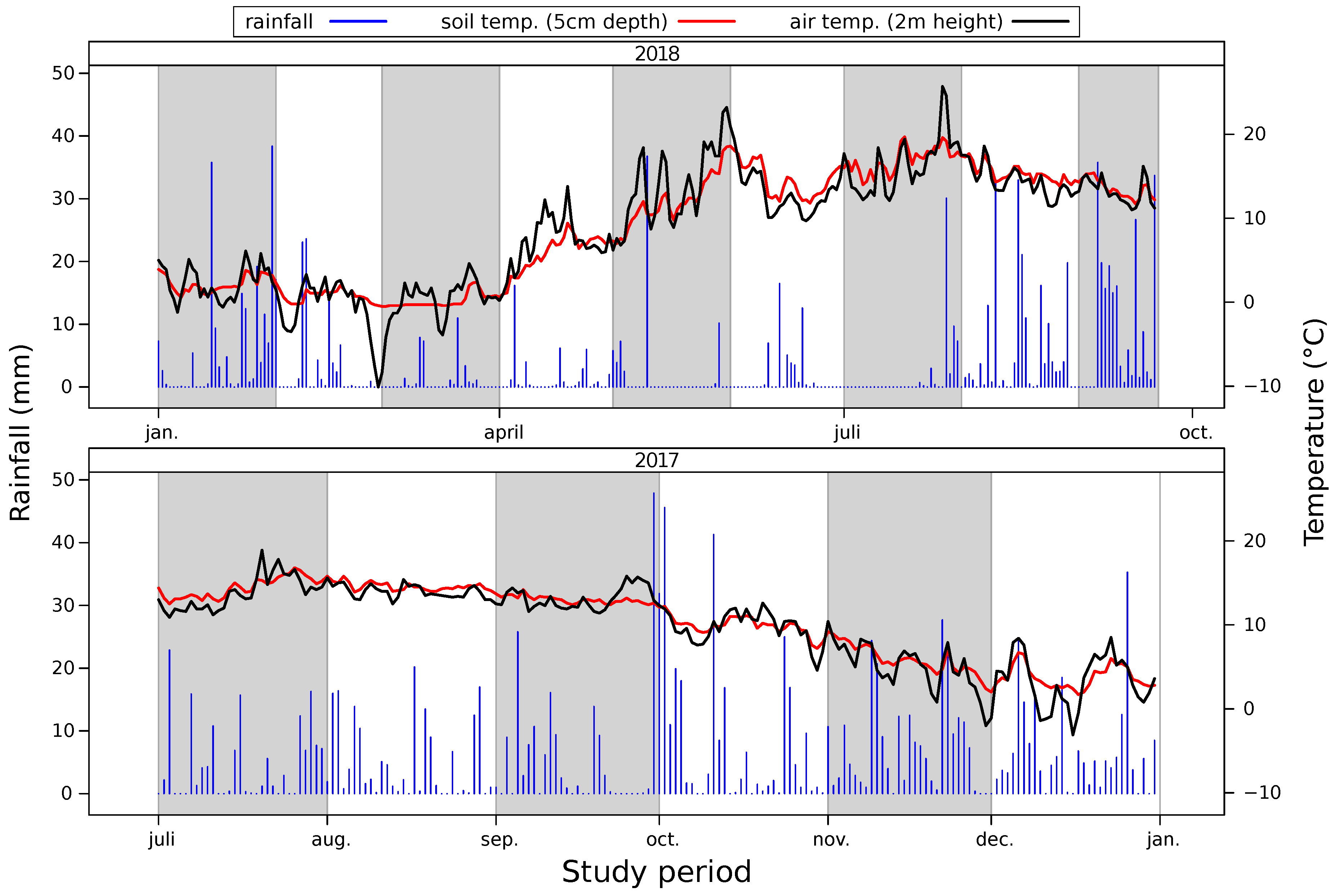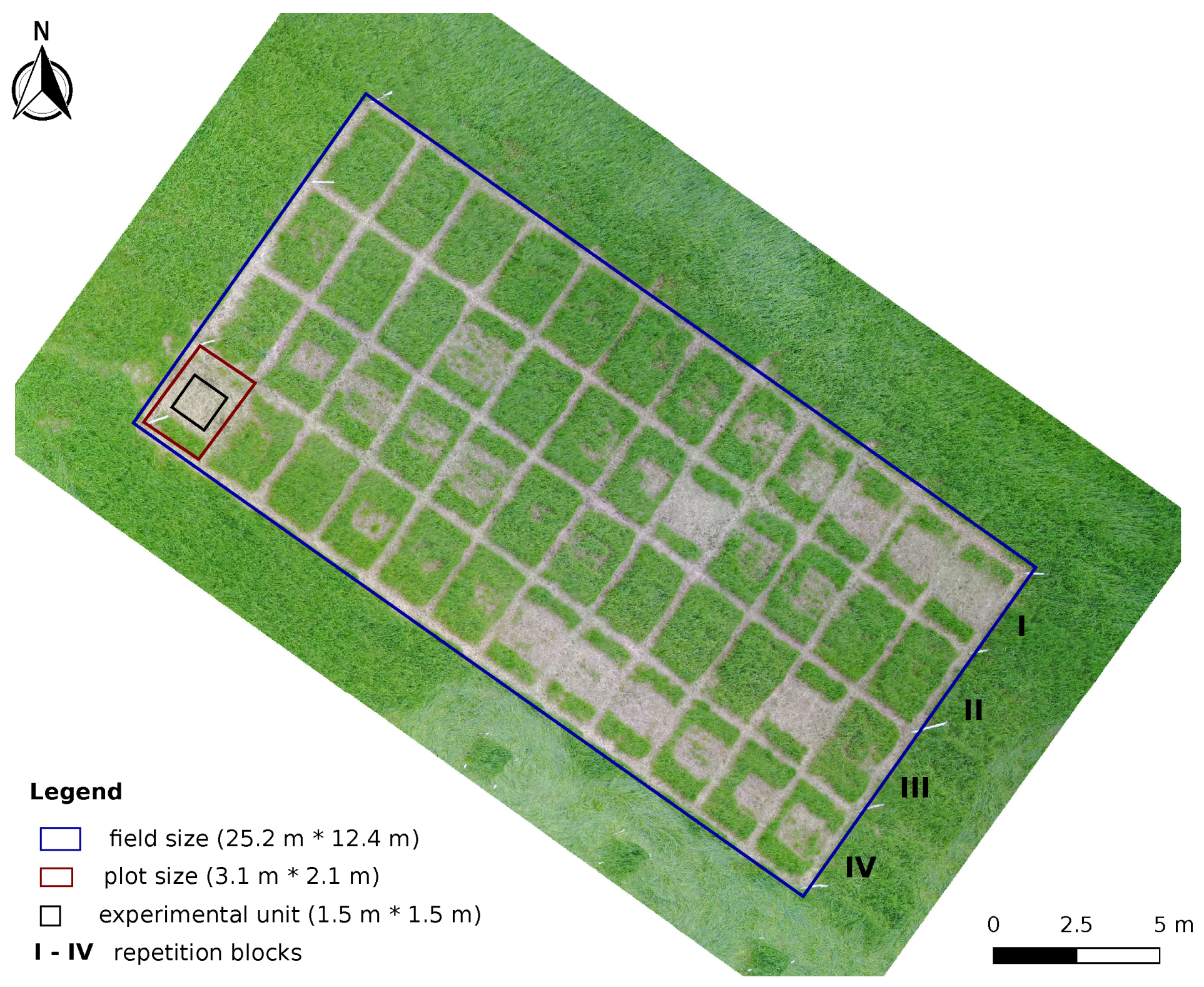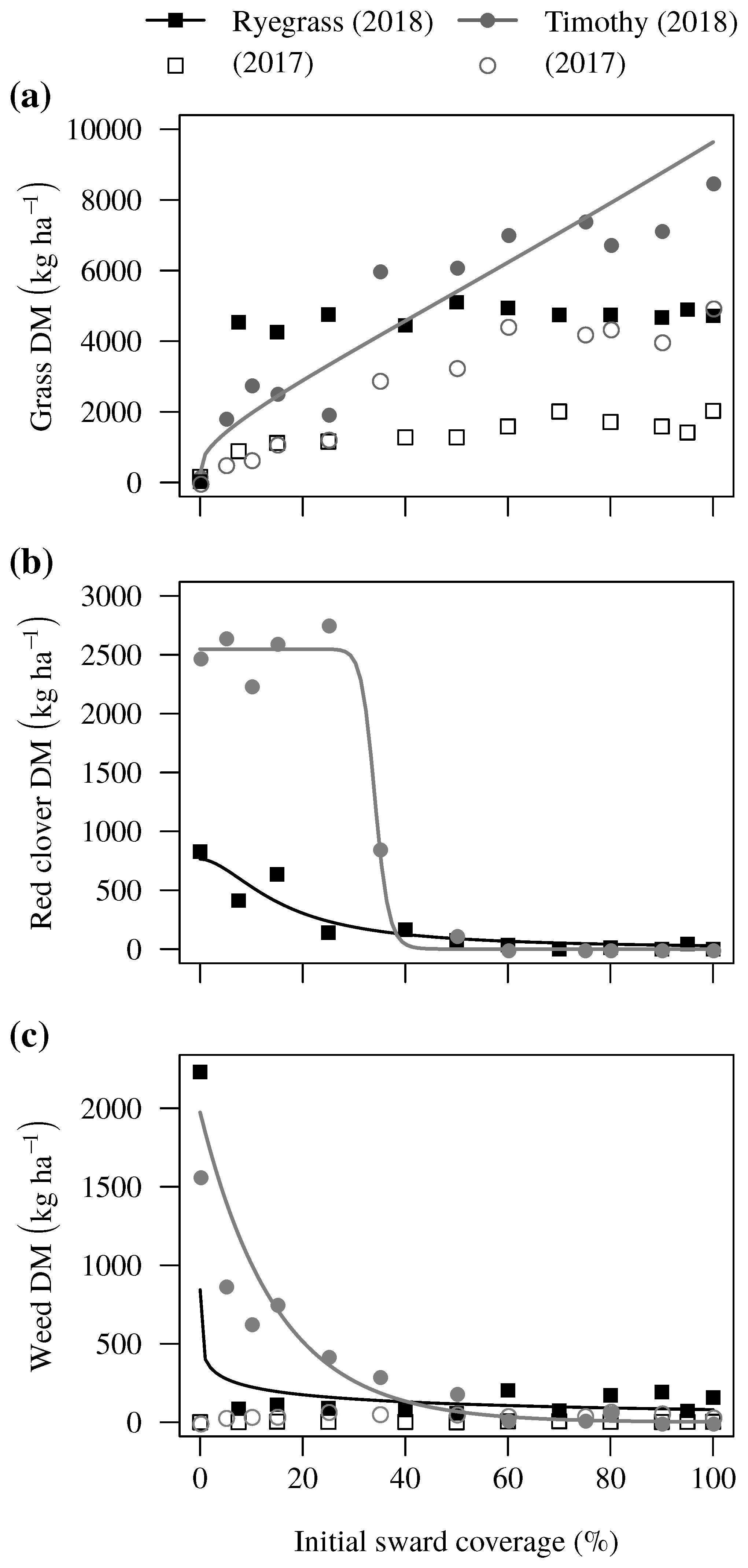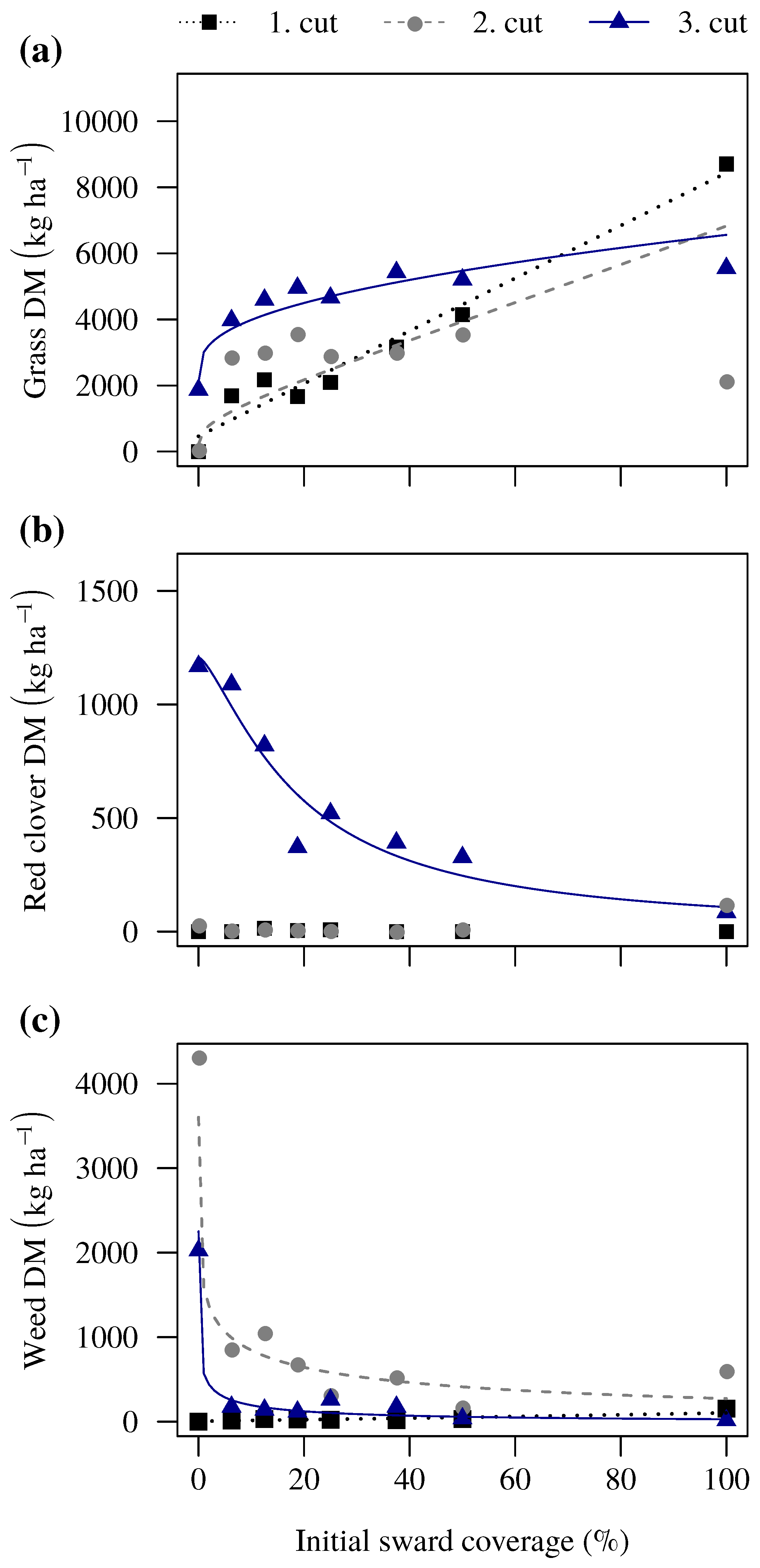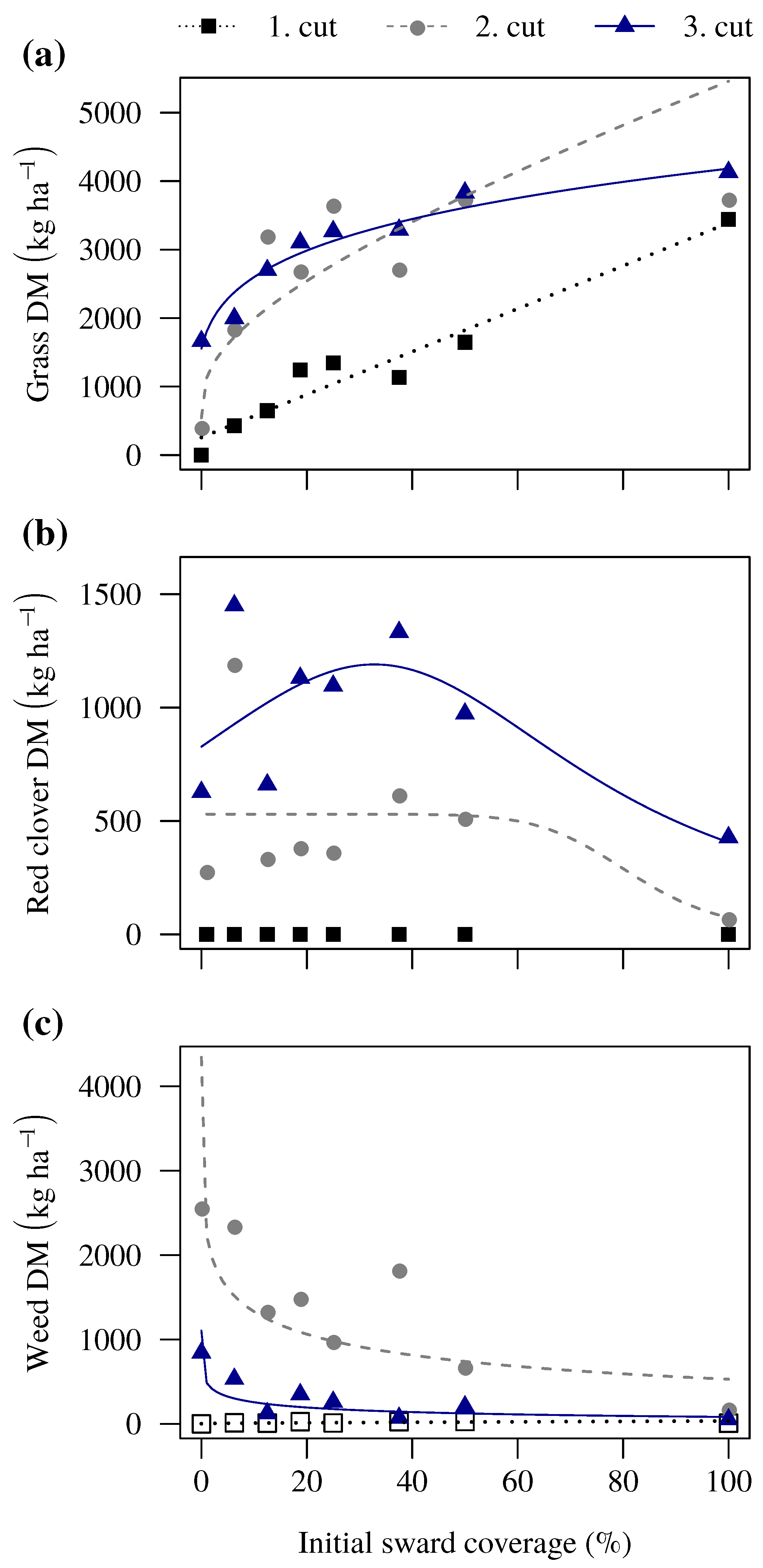1. Introduction
Forage grasses serve as the main source of energy and nutrients for ruminant livestock in many regions of the world. Grass-based dairy and meat production constitutes the economic backbone of agriculture in Northern Europe. Forage grass production systems need to be based on precise usage of inputs and optimal application of available technology to be cost-efficient and to minimize the forage production environmental footprint. Reseeding is a required measurement for preserving the productivity of a grass sward [
1], or for diversity maintenance on grassland communities [
2]. Sod-seeding is often used in cases where plowing is difficult or risky, when the botanical composition of the sward needs to be improved, or on farms seeking to exploit the feed value and N-fixing properties of legumes [
3]. Direct drilling of desired forage species into the existing sod, i.e., sod-seeding, aims at increasing both grass productivity and quality [
4,
5]. Due to the low demands of labour, equipment and fuel, and by keeping the original vegetations sod-seeding reduces the risk of soil erosion and improves economic, environmental and agronomic grass management assets, without the production loss during the establishment season, associated with reseeding after plowing [
6].
A desirable way to increase pasture productivity and quality is via legumes sod-seeding. The most commonly used legume species in Northern Europe and Northern America are red clover (
Trifolium pratense L.), white clover (
Trifolium repens L.), and alfalfa (
Medicago sativa L.), which mainly contribute with potential nitrogen fixation, stabilization of forage dry matter and increasing forage protein content [
3,
4,
7]. However, introducing legumes can be very challenging, particularly in well-established stands where competition is strong [
8,
9]. Such stands may have a good sward coverage (e.g., >75%) across the field, and some phytotoxins may be released through the living grass roots to prevent germination and root growth of legume seedlings [
10] or through the decomposition of grass killed by ice-encasement [
8]. Adequate species selection and suppressing competition are defining keys for successful establishment, even more than the seeding rate, the time of application or type of machinery [
5,
11]. In practical terms, this technique may often provide renovation success in short time, but its long-term success depends on many uncertainties of natural and management sources, i.e., seeds germinate, but the seedlings fail to establish [
12].
Sod-seeding has been subject of research for many decades, to determine effectiveness of the seed drill [
13]; identify optimal seed mixtures and seeding rates [
1]; determine functions in ecosystems of grass mixtures [
14]; establishment success in relation to sowing methods, depth and width of cultivation and sowing date [
3,
6,
8]; effects of suppression treatments prior reseeding to reduce competition with existing sward [
5,
9]; identification of factors determining establishment success of newly sown forage legumes [
4]; and effects of application of slurry together with sod-seeding in one operation [
15]. This research has led to the development of many general guidelines concerning how to ensure establishment success, often involving measures to improve the contact between seeds and soil by tillage and management operations to reduce competition from the existing sward, such as defoliation or herbicide application. Although many authors have pointed out the density and competitiveness of the existing vegetation as key determinants of establishment success, systematic studies relating establishment to different sward covers are lacking in the literature. Without such information, it is difficult to establish objective criteria for evaluation of the suitability of a field for reseeding and to provide management guidelines.
Based on general observations in one field trial, Frick and Rühlmann [
11] suggested that sod-seeding can only be successfully applicable under specific sward conditions, i.e., thresholds. These authors suggested that an evenly distributed grass coverage between 15 and 30% with the desired grass species, and more than 50% of bare soil, assessed visually in early spring, justifies sod-seeding operations. From those indicators and empirical knowledge of local grassland producers, recommendations are provided to farmers in Switzerland for applying sod-seeding, at least three times in the growing season [
16,
17]. To come a step further, the sward coverage conditions need to be accurately measured with the aid of current technological tools, to enable replication of results on other sites. The experiments should be designed to evaluate the sward conditions at different developmental stages or seasons, comparing effects on the most economically important grass species for forage production for that determined site. Therefore, the objective in this study was to test if thresholds for successful establishment of red clover can be determined using sod-seeding on two ley grass fields dominated by timothy (
Phleum pratense L.) and perennial ryegrass (
Lolium perenne L.), respectively, at various sward coverage (density) levels, applied at early spring and late summer. The hypotheses was that the establishment of red clover plants is highly successful at zero initial sward coverage and decreases exponentially as the coverage increases. Red clover was the legume sown by direct drilling to enrich the pasture quality, with the additional advantage that this species allowed an easier discrimination of newly emerged seedlings inside the well established grass stand.
3. Results
Forage yield was evaluated as dry weight of grass and red clover biomass at final harvest. In the SUM-R experiment, the biomass production of ryegrass only was little affected by the initial sward coverage, because GDM production was similar at all coverage levels above 0% (
Figure 4a, black symbols and line). SUM-R grass data were poorly fitted by the proposed models (R
2 < 0.60), and the same occurred when quadratic models were applied (R
2 < 0.50, not shown). For ryegrass, the GMD was much lower at 0% initial soil coverage than at the other coverage levels, with no clear differences between the latter. For the SUM-T experiment, timothy GDM was explained by Equation (5) (
Figure 4a, gray symbols and line), indicating a fast grass regrowth even at low sward coverage levels, but with lower biomass production capability than fully covered plots. Comparing the harvests in summer 2017 (
Figure 4a, hollow symbols) and spring 2018 (
Figure 4a, filled symbols), GDM was twice as high in the 2018 harvest. Timothy showed a threshold around 35% initial coverage, below which GDM did not recover fully (
Figure 4a, gray-filled circles;
Table 2). The regrowth ability of ryegrass was stronger than timothy (parameters
c in
Table 2). The threshold for ryegrass was around 10% (
Figure 4a, black-filled squares).
At final harvest on SUM experiments, RCDM was higher in the timothy field, compared with the ryegrass field (
Figure 4b), indicating a greater establishment success in the former. RCDM data fitted Equation (
1) for both grass mixtures, and the thresholds for successful sod-seeding was represented by the parameter
. Nearly 2500 kg ha
−1 RCDM were produced on timothy (
Figure 4b, gray-filled circles), being at its maximum at
(
Table 2). For ryegrass (
Figure 4b, black-filled squares), less than 1000 kg ha
−1 RCDM were produced at an
near 10%, which was not significantly different than the
for timothy, due to overlapping confidence intervals (
Table 2). Above 50% initial sward coverage, RCDM was minimal and approached 0 kg ha
−1 on both grass mixtures.
The weed biomass development was similar as RCDM, except that more WDM than RCDM appeared on plots with 0% sward coverage and WDM fell markedly with increasing coverage (
Figure 4c), according to Equations (7) (ryegrass) and (6) (timothy). On ryegrass,
kg ha
−1 WDM was produced below 15% sward coverage; the weed decay parameter
indicated a strong and fast weed suppression to almost zero WDM with increasing ryegrass coverage (
Table 2;
Figure 4c, black-filled squares). On timothy, about 1500 kg ha
−1 WDM was harvested at first cut in 2018, compared with the nearly 0 kg ha
−1 in the summer cut in 2017 (
Figure 4c, gray-filled circles). The weed decay was significantly smaller (
,
Table 2) than in ryegrass, with almost 500 kg ha
−1 WDM at 20 to 30% initial sward coverage, indicating a lower capability of timothy to suppress weeds.
In SPR experiments, GDM recovery was linear at cut 1 and exponential at cuts 2 and 3 (
Table 2), increasing as the initial sward coverage approached 100% for both grass mixtures, ryegrass (
Figure 5a) and timothy (
Figure 6a). At cut 1, GDM was still constrained below 50% sward coverage, but already at cut 2, the grass biomass developed between 10% and 60% sward coverage was not different than that at 100% coverage. This effect was evident by the grass regrowth parameters for ryegrass (
) and timothy (
),
Table 2, without statistical difference between the two grass types. Red clover yield was also dependent on the species present in the grass mixture. A more successful establishment and biomass red clover development was observed on timothy (
Figure 6b) than on ryegrass (
Figure 5b). RCDM was around 1000 kg ha
−1 in ryegrass if sod-seeding was applied when the initial sward coverage was low. Nevertheless, about 500 kg ha
−1 RCDM were still produced, even above 50% coverage. Effective coverage for RCDM could only be estimated at cut 3 for ryegrass, and from cut 2 onward for timothy (
Table 2). An
of nearly 10% (and below 20%) allowed a good red clover estabishment in ryegrass, while RCDM was important and significant in timothy even between 47 and 68%
, at cut 2 and cut 3, respectively.
WDM behaved in SPR comparably to SUM experiments, although the maximum WDM was higher in the latter (
Figure 5c and
Figure 6c). At cuts 2 and 3, WDM data of both grass mixtures fitted Equation (7), and the weed decay parameters showed no significant difference between both crops, as confidence intervals overlapped (
Table 2). Weed biomass was extremely high at cut 2 in ryegrass
Figure 5c, being nearly 4000 kg ha
−1 at an initial sward coverage of 0%, but decreasing to about 500 kg ha
−1 when the coverage was >30% and up to 100%. At cut 3, the WDM was above 2000 kg ha
−1 at 0% sward coverage, but it was significantly reduced to almost 0 kg ha
−1 as the coverage increased above 6.5%. In timothy, the WDM at cut 2 was around 2500 kg ha
−1 at 0% coverage and decreased to 500 kg ha
−1 at >50% coverage
Figure 6c. At cut 3, the WDM was below 1000 kg ha
−1 at 0% sward coverage, and it decreased close to 0 kg ha
−1 only when the coverage was 40% or higher.
4. Discussion
Although sod-seeding is highly recommended to maintain a sustainable forage production, together with adequate fertilization management and usage, this study shows that only at a low initial sward coverage a good seedling establishment and biomass production may be achieved by sod-seeding red clover. The results presented here indicate that the initial sward coverage at the time of reseeding may be a good variable to determine if a grass sward requires renovation and to define the corresponding thresholds for successful sod-seeding. This is an important finding because sward coverage can be objectively determined via image analysis, and measurements can easily be repeated in space and time. Thus, thresholds can be adjusted to a site-specific location, using the current advances of remote sensing and precision application technology. Previous studies generally did not consider using sward coverage for determining the necessity for grassland renovation. The only study using this variable, to indicate when sod-seeding can be successfully be applied [
11], did not use objective and repeatable methods for assessing coverage.
The hypothesized trend of better red clover establisment and biomass production as a result of sod-seeding at 0% initial cover was only partially visible, only in ryegrass fields. In a supplementary assessment in the SUM experiment, we monitored the development of red clover seedlings from two weeks after the sod-seeding date, when at least 95% of seedlings had the spade leaf fully developed on all plots, until five weeks later. Germination and early establishment of red clover seedlings on all plots and sward coverage levels were uniform, after which number of seedlings decreased exponentially with increasing initial sward coverage (data not shown). A good establishment and survival of red clover plants up to the final harvest was observed at sward coverages between 0–30% in timothy (
Figure 4b, gray symbols). In contrast, the nonlinear trend Brain-Cousens, Equation (2), explaining the higher red clover establishment and biomass on low to medium sward coverage in SPR-T experiment was unexpected. There, red clover establishment was optimal in the timothy sward coverage range 30–45% (
Figure 6b). Apparently, the initial timothy coverage below 10% presented unfavorable conditions for a permanence of red clover until harvest in this experiment. That behaviour also contrasts with both ryegrass fields, where red clover establishment was clearly the best at 0% initial sward coverage (
Figure 4b, black symbols; and
Figure 5b).
The red clover biomass generated in timothy plots (
Figure 4b, gray symbols;
Figure 6b) imply relatively favourable conditions for red clover establishment at intermediate initial sward coverage levels, while for ryegrass plots (
Figure 4b and
Figure 5b) conditions constrained the establishment. It has been reported that some diploid ryegrass cultivars are poorly compatible with clover plants [
26], as they produce relatively closed swards (in contrast to the more open swards of tetraploids). A zero or close-to-zero coverage could cause minimal above ground competition. Root competition is most likely more important under such conditions, especially in swards of vigorously growing species [
8]. Nevertheless, the presence of a few original grass stand plants (i.e., sward coverage
) was presumably more beneficial and offered a protective environment for a better establishment of red clover seedlings in one of the timothy fields, which may be an example of a facilitative interaction [
27]. If the initial sward coverage was compared with herbicide effects in dose-response experiments, the ‘low-dose’ coverage triggering the development of red clover seedlings would be comparable to the hormesis effect [
20]. Consequently, instead of the hypothesized exponential survival decay, the adequacy of the Brain-Cousens model with four parameters (2) would explain the beneficial and protective effect of low coverage. An additional advantage of this modeling approach was the estimation of effective sward coverage (
), as the thresholds at which sod-seeding may actually be needed and successfully implemented.
The time for full establishment of red clover, i.e., when plants are large enough to contribute significantly to the total forage yield, varied according to the season when sod-seeding was applied. In SUM experiments sod-seeding was done in July, after cut 2, and substantial red clover biomass production could only be measured at cut 1 in the subsequent season, i.e., after the winter (
Figure 4b). However, before that winter some well-developed red clover plants were visible, although not big enough to be part of the harvest. Komárek et al. [
3] and Seguin [
4] identified a span of 2 months after sod-seeding to evaluate a successful survival of red clover. They observed similar survival rates, regardless if sod-seeding was done after cut 1 (June), cut 2 (August) or in September. Our study indicates that red clover establishment needs much longer time than two months after sod-seeding to be definitive (e.g., more than 4 months). This situation was also evident for sod-seeding applied in early spring (SPR experiments). In these experiments, with sod-seeding applied in April, a significant red clover biomass became measurable only at cut 3 in both, ryegrass (
Figure 5b) and timothy (
Figure 6b), meaning month five after the date of sod-seeding. Consequently, sod-seeding experiments with red clover should be continuously monitored for at least half a year post seeding before establishment success is evaluated.
The thresholds for sod-seeding estimated in the present study illustrate the challenges associated with sod-seeding of red clover in the two main grass species used in Norway, and the different effects between these species. Sod-seeding in ryegrass at an initial sward coverage above 10% did not allow a successful red clover seedling establishment in our study, neither in late summer, nor in early spring. Previous trials (9) in the same region showed that ryegrass sward renovation by sod-seeding or wet-seeding was successful only in fields with >50% bare soil, and although new ryegrass plants established, no improvements were measurable in total forage yield [
28]. The authors concluded that sward renovation might only be profitable when forage yield and quality are improved, with the least costs for labor and seeds. Conversely, reference [
11] found that a sward coverage containing nearly 30% of various desired ryegrass species, allowed a good establishment of perennial ryegrass, increasing its content to above 50% even three years after sod-seeding with a grass-legume mixture sown in June–August. However, in that study other conditions for reseeding and management were implemented, which were not used in the presented here. In the Swiss case, the original sward stand had only 4% of perennial ryegrass and more than 50% bare soil. Moreover, in the same case plots were sprayed with a 10% dosage of glyphosate prior sod-seeding, and between 3 and 5 cuts were done, as early as possible, after sod-seeding. Suppression treatments were not applied in our study, as it was intended identifying the sward conditions at which sod-seeding is justified, without including extra operations which may increase the production costs per unit of forage. For timothy based swards, no corresponding reseeding thresholds had been suggested before. Based on the results, we suggest that sod-seeding in a timothy sward may offer reasonably good probabilities for a successful establishment of red clover at initial sward coverage levels opt to 30% late summer, and up to 50% in early spring.
In line with our hypothesis, the grass yield of the original sward stand at the final harvest was negatively affected by the pre-experimental treatment, when the initial sward coverage was reduced (by spraying herbicide) to below 35% in the timothy swards, while the ryegrass swards showed a good recovery, already at around 15% of initial coverage. It is possible that the benefits of sod-seeding in a ryegrass sward can be visible only when the pasture condition is below this level, and renewal is applied without suppression treatments. Ryegrass has an great shoot competition capability over time [
8], thus it can cover the bare soil spots much faster than timothy, suppress opportunistic weeds more strongly, and recover the biomass production and herbage quality status of the pasture, especially if fertilization is well managed [
11,
12]. This apparent disadvantage of timothy was well compensated with the successful introduction of red clover by sod-seeding. The red clover biomass produced was enough to level up the pasture yield in plots with coverage around 15–50% coverage (in SUM-T) and 20–60% (in SPR) to the average total forage biomass. Therefore, sod-seeding adjusted on those thresholds did in fact increment the clover biomass, which might improve forage yield quality, and contributed to avoid yield loses. Moreover, although not evaluated in this study, positive economic and environmental effects of sod-seeding should be accounted for, because no suppression treatments to the original sward were used, thus diminishing the corresponding costs of suppression operations and soil compaction due to reduced traffic. At the same time, it should be noticed that we created different coverage levels by spraying glyphosate to the desired level. The capability to regrow after other types of injuries, such as winter kill, may differ from the study situation. More experiments are needed to establish thresholds for different sward conditions and interactions with the environment.
